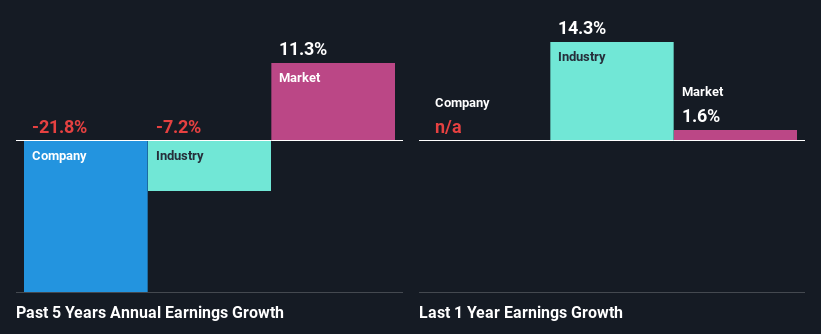Weak Financial Prospects Seem To Be Dragging Down Helios Underwriting plc (LON:HUW) Stock
It is hard to get excited after looking at Helios Underwriting's (LON:HUW) recent performance, when its stock has declined 17% over the past three months. To decide if this trend could continue, we decided to look at its weak fundamentals as they shape the long-term market trends. In this article, we decided to focus on Helios Underwriting's ROE.
Return on equity or ROE is a key measure used to assess how efficiently a company's management is utilizing the company's capital. In short, ROE shows the profit each dollar generates with respect to its shareholder investments.
Check out our latest analysis for Helios Underwriting
How Do You Calculate Return On Equity?
The formula for return on equity is:
Return on Equity = Net Profit (from continuing operations) ÷ Shareholders' Equity
So, based on the above formula, the ROE for Helios Underwriting is:
3.4% = UK£4.0m ÷ UK£117m (Based on the trailing twelve months to June 2023).
The 'return' is the profit over the last twelve months. One way to conceptualize this is that for each £1 of shareholders' capital it has, the company made £0.03 in profit.
What Is The Relationship Between ROE And Earnings Growth?
We have already established that ROE serves as an efficient profit-generating gauge for a company's future earnings. Based on how much of its profits the company chooses to reinvest or "retain", we are then able to evaluate a company's future ability to generate profits. Assuming all else is equal, companies that have both a higher return on equity and higher profit retention are usually the ones that have a higher growth rate when compared to companies that don't have the same features.
Helios Underwriting's Earnings Growth And 3.4% ROE
On the face of it, Helios Underwriting's ROE is not much to talk about. A quick further study shows that the company's ROE doesn't compare favorably to the industry average of 8.5% either. Therefore, it might not be wrong to say that the five year net income decline of 22% seen by Helios Underwriting was probably the result of it having a lower ROE. We reckon that there could also be other factors at play here. For instance, the company has a very high payout ratio, or is faced with competitive pressures.
Furthermore, even when compared to the industry, which has been shrinking its earnings at a rate of 7.2% over the last few years, we found that Helios Underwriting's performance is pretty disappointing, as it suggests that the company has been shrunk its earnings at a rate faster than the industry.
Earnings growth is a huge factor in stock valuation. What investors need to determine next is if the expected earnings growth, or the lack of it, is already built into the share price. By doing so, they will have an idea if the stock is headed into clear blue waters or if swampy waters await. Is Helios Underwriting fairly valued compared to other companies? These 3 valuation measures might help you decide.
Is Helios Underwriting Efficiently Re-investing Its Profits?
With a high LTM (or last twelve month) payout ratio of 54% (implying that 46% of the profits are retained), most of Helios Underwriting's profits are being paid to shareholders, which explains the company's shrinking earnings. With only very little left to reinvest into the business, growth in earnings is far from likely. Our risks dashboard should have the 2 risks we have identified for Helios Underwriting.
Moreover, Helios Underwriting has been paying dividends for nine years, which is a considerable amount of time, suggesting that management must have perceived that the shareholders prefer consistent dividends even though earnings have been shrinking. Our latest analyst data shows that the future payout ratio of the company over the next three years is expected to be approximately 47%. Regardless, the future ROE for Helios Underwriting is predicted to rise to 13% despite there being not much change expected in its payout ratio.
Conclusion
Overall, we would be extremely cautious before making any decision on Helios Underwriting. As a result of its low ROE and lack of much reinvestment into the business, the company has seen a disappointing earnings growth rate. Having said that, looking at current analyst estimates, we found that the company's earnings growth rate is expected to see a huge improvement. To know more about the company's future earnings growth forecasts take a look at this free report on analyst forecasts for the company to find out more.
Have feedback on this article? Concerned about the content? Get in touch with us directly. Alternatively, email editorial-team (at) simplywallst.com.
This article by Simply Wall St is general in nature. We provide commentary based on historical data and analyst forecasts only using an unbiased methodology and our articles are not intended to be financial advice. It does not constitute a recommendation to buy or sell any stock, and does not take account of your objectives, or your financial situation. We aim to bring you long-term focused analysis driven by fundamental data. Note that our analysis may not factor in the latest price-sensitive company announcements or qualitative material. Simply Wall St has no position in any stocks mentioned.

 Yahoo Finance
Yahoo Finance 
